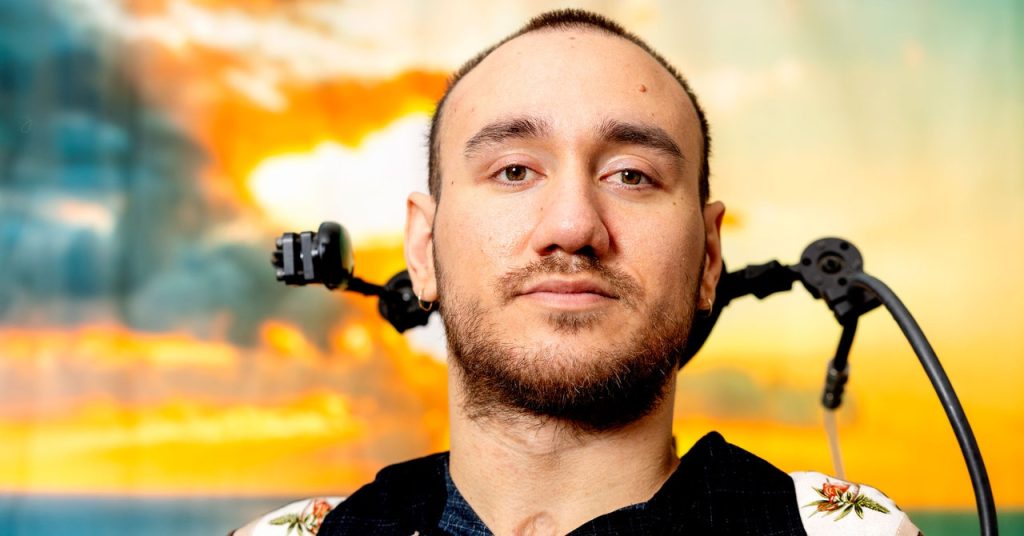A Life Transformed: Noland Arbaugh’s Journey with Neuralink
The Accident That Changed Everything
In 2016, Noland Arbaugh’s life took a dramatic turn when he suffered a spinal cord injury while swimming in a lake. He recalls diving into the water and hitting his head on something or someone, leaving him paralyzed from the neck down. This incident forced him to move back in with his parents and rely on them for his daily needs.
Adjusting to a New Reality
Arbaugh had to adapt to life in a wheelchair and learned to use a mouth-held stick to operate an iPad. However, the hardest part was feeling like a burden on his family. Despite these challenges, he remained determined to regain some independence.
Enter Neuralink: A Ray of Hope
The Birth of Neuralink
In the same year, Elon Musk co-founded Neuralink, a brain implant startup aimed at helping people like Arbaugh. The experimental device has given Arbaugh a new sense of independence, allowing him to control a computer almost entirely on his own.
I was blown away at what they were trying to do. You know, Elon Musk, he has had such an impact on the world, whether people think that’s good or bad. It was really cool knowing that he was a part of something like this. I really feel like we’re kindred spirits with our mentality of wanting to better humanity.
The Screening Process
Arbaugh underwent a rigorous screening process to qualify for the Neuralink trial. This included multiple Zoom interviews, medical screenings, and a full day of tests at a hospital. Despite the extensive process, Arbaugh remained hopeful but cautious.
The Implant Experience
Initial Concerns
Arbaugh had some reservations about undergoing brain surgery, especially since his brain was his most valuable asset as a quadriplegic. He also worried about being the first to receive the implant and the potential risks involved.
The first is that I’m a quadriplegic, and all I really have is my brain. So letting someone go in there and mess around, it’s a big commitment. If something goes wrong, that’s kind of it for me. But I knew I wanted to help out, and I didn’t want to let my fears get in the way of that.
Post-Surgery Adjustments
After the surgery, Arbaugh faced unexpected challenges, such as recalibrating the device to match his brain’s movements. It took about two weeks to get back to the cursor speed he was accustomed to, but things improved steadily from there.
 Photograph: Cassidy Araiza
Photograph: Cassidy Araiza
Life After Neuralink
Gaining Independence
The Neuralink implant has significantly increased Arbaugh’s independence, reducing his reliance on others and making him feel less like a burden. He can now browse the web and play computer games whenever he wants.
It’s just made me more independent, and that helps not only me but everyone around me. It makes me feel less helpless and like less of a burden. I love the fact that the people around me don’t have to wait on me so much. Outside of being completely healed, I believe what most quadriplegics want is independence.
Future Aspirations
Arbaugh dreams of a future where he could control a Tesla Optimus robot with his implant, making him even more self-sufficient. He also hopes to connect his implant to a self-driving car, further enhancing his mobility.
 Photograph: Cassidy Araiza
Photograph: Cassidy Araiza
Looking Ahead
Meeting Other BCI Users
Arbaugh has yet to meet other Brain-Computer Interface (BCI) users but is eager to connect with them. He believes sharing experiences could be beneficial for everyone involved.
I’m excited to have a buddy in this, someone to compare notes with. It will be nice to get a different perspective. I only have a few months on the next participant, but I want to help out in any way I can and be available for any questions they have. I guess my role in all this is sort of like a big brother.
The Next Frontier
Arbaugh envisions a future where BCIs can translate languages in real-time and even write into the brain, although he acknowledges the ethical considerations involved.
 Photograph: Cassidy Araiza
Photograph: Cassidy Araiza
Conclusion
Noland Arbaugh’s journey with Neuralink showcases the transformative potential of brain implants. While challenges remain, the strides made in this field offer hope for a more independent future for individuals with severe disabilities. For more information, visit Neuralink.

5 Comments
Imagine the headlines if it malfunctions!
Question: Could this be the beginning of human enhancement or ethical dilemmas?
Isn’t it incredible how far we’ve come with technology!
Can’t help but wonder if it’s a leap forward or a ticking time bomb.
Sapphire: Brace yourself for the ethical debates this tech will ignite.